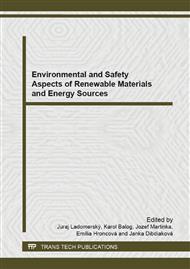[1]
X. L. Xing, B. T. Jiang, Y. Q. Jia and X. Zhang, in: Study on Environmental Pollution and Public Health Caused by Chemical Accidents, edited by Z. Liu, X. Dong, Z. Liu and Q. Liu, volumes 807 – 809 of Advanced Materials Research (2013).
DOI: 10.4028/www.scientific.net/amr.807-809.624
Google Scholar
[2]
V. R. Dhara and R. Dhara: The Union Carbide Disaster in Bhopal: A Review of Health Effects. Archives of Environmental Health. Vol. 57 (2002), pp.391-404.
DOI: 10.1080/00039890209601427
Google Scholar
[3]
A. C. Pesatori, D. Consonni, S. Bachetti, C. Zocchetti, M. Bonzini, A. Baccarelli and P. A. Bertazzi: Short- and Long-Term Morbidity and Mortality in the Population Exposed to Dioxin after the Seveso Accident,. Industrial Health. Vol. 41 (2003).
DOI: 10.2486/indhealth.41.127
Google Scholar
[4]
Council Directive 2013/59/Euratom of 5 December 2013 laying down basic safety standards for protection against the dangers arising from exposure to ionising radiation, and repealing Directives 89/618/Euratom, 90/641/Euratom, 96/29/Euratom, 97/43/Euratom and 2003/122/Euratom.
DOI: 10.1093/oxfordjournals.rpd.a032482
Google Scholar
[5]
Council Directive 2012/18/EU of 4 July 2012 on the control of major-accident hazards involving dangerous substances, amending and subsequently repealing Council Directive 96/82/EC.
DOI: 10.1016/s0921-9110(98)80021-9
Google Scholar
[6]
Information on https: /www. gov. uk/government/publications/emergency-responder-interoperability-lexicon.
Google Scholar
[7]
Method for Developing Arrangements for Response to a Nuclear or Radiological Emergency: Updating IAEA-TECDOC-953. (International Atomic Energy Agency, Austria 2003).
Google Scholar
[8]
IAEA Safety Standard Series: Preparedness and Response for a Nuclear or Radiological Emergency. (International Atomic Energy Agency, Austria 2002).
Google Scholar
[9]
J. Kubanyi, R. B. Lavin, D. Serbanescu, B. Toth and H. Wilkening: Risk Informed Support of Decision Making in Nuclear Power Plant Emergency Zoning. (Office for Official Publications of the European Communities, Luxembourg2008).
Google Scholar
[10]
Information on http: /response. restoration. noaa. gov/sites/default/files/ALOHA_Tech_Doc. pdf.
Google Scholar
[11]
Information on https: /www. tsoft. cz/sites/default/files/download/TEREX_Terroristic_expert_EN. pdf.
Google Scholar
[12]
G. O. Rogers, A. P. Watson, J. H. Sorensen, R. D. Sharp and S. A. Carnes: Evaluating Protective Actions for Chemical agent Emergencies. (Oak Ridge National Laboratory1990).
DOI: 10.2172/6873743
Google Scholar
[13]
D. Řehák, D. Kratochvílová, jr. and D. Kratochvílová, in: Perspective of the Population Sheltering in the Context of Actual Safety Threats, Sborník přednášek XIII. ročníku mezinárodní konference Ochrana obyvatelstva, SPBI Ostrava (2014).
Google Scholar
[14]
A. Birenzvige: A Model to Predict the Threat of Exposure to Chemical Warfare Agents in Enclosed Spaces. (USAARDCOM Chemical Systems Laboratory, Maryland 1983).
Google Scholar
[15]
R. L. Stearman: Protection against chemical attack provided by buildings (U. S. Army Dugway Proving Ground, Dugway, Utah 1985).
DOI: 10.1163/9789004346673.wmdo-09_111
Google Scholar
[16]
CO-6-1. Příprava, projektování a výstavba protiradiačních úkrytů (Ministry of National Defence, Praha 1978).
Google Scholar


